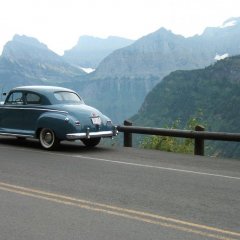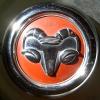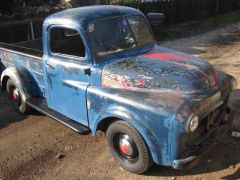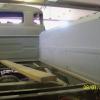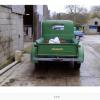Leaderboard
Popular Content
Showing content with the highest reputation on 08/21/2016 in all areas
-
3 points
-
1 point
-
Went to the Springfield, MO antique car swap meet yesterday, It's held at the Ozark Empire Fairgrounds and usually has a lot of vendors.......most of whom have very little or no parts for a Plymouth P15. However I got lucky and stumbled onto four different sellers who had a few things of interest .... and their prices were reasonable. One guy had some N O S headlight trim rings and a new starter. Another had a pair of new, un-used 10 inch hubcaps. Another had the inner headlight mounting rings (for 50 cents each), and one had a new old stock glass tail light lense for $2. So......it just shows "you never know". Oh, and I also found a pair of "diamond studded" license plate frames for Mary Ann's Lexus.1 point
-
Quite often play in the ends of the drag link is a major cause of steering problems. Be sure and check your tie rod ends and the drag link ends (easy to do) before assuming that the steering boxneeds "help." My B4B had lots of free play in the steering. First I centered its wheels like I was driving straight, then I crawled under the truck and had my son move the steering wheel slowly left then right. I watched the ends of the drag link and looked for free play - that's where my problem was, and it wasn't much free play. I could tell it was free play because the pitman arm would move, prior to the drag link moving. Both ends of the drag link had some free play. A little free play at the drag link or tie rod ends translates to a lot of free play at the steering wheel. I replaced the drag link and that eliminated the large amount of free play at the steering wheel. Once you have eliminated the drag link or the tie rod ends as the source of free play, then address steering box play by adjusting it. At least, this approach worked for me.1 point
-
OP has not been on in 5 years. Not sure if any current suggestions will be much help1 point
-
I'm kinda wondering if worn valve guides may be the cause of the not-so-smooth exhaust...if the valves are rattling around a little, they may get hung up before that instant that they need to closed...also, I recall that the engine idle speed should be closer to 450-500 rpm...I do not recall where I read it, but there is a way to replace worn valve guides with the engine in the truck. It involves a valve guide installation tool, a hammer, a cold chisel, and a lot of patience...I was able to replace the guides on the '49 while the engine block was in the truck, and if I over drove the guides, then I could carefully use a long pry bar to adjust the guide height1 point
-
1) Locate the serial number, it'll tell the truth more than any one person could tell ya...you can request a build card at some point to really know how the truck was supposed to leave the factory. A thorough inspection of the frame is a must if you suspect there may be rust issues. I have seen rust thru on the frame of some parts trucks near the forward rear spring hangers that could be a bear to repair properly. Who knows what kind of coating is on that frame...if ya remove paint in suspected rusty areas on the frame, you could go back and top coat it with more black paint...only the sharp eyed nit pickers may question why the frame paint has some inconsistencies in it. 2) If you rewire for a 6V system, then you could update to a 12V system later if you feel the need. New wiring, including battery cables, usually solves most problems with the 6V systems as impedance is greatly minimized from the corroded and tattered original wiring. I would think there are electric wiper options available for the '47 as the cab is pretty much the same as in vintage Power Wagons. 3) The engine argument of 218 vs 230 is something I too have wrassled with of late. My '48 has a '55 Plymouth 230 that has been in there for half a century...I have found a '50 Plymouth 218 that is more accurate compared to the original engine that the truck left the factory with, but it's not really original either. And as far as power difference between the 218 and the 230, a 218 can be massaged to pump out 230 power levels, which are still quite low by today's standards. From a cost perspective, if you have an engine ready to install, I say use it, cuz that's probably how that truck got the replacement engine in the first place. 4) If this truck left the factory as a chassis cab, you could put anything back there that you want...except for a swing set, that would just look odd. 5) From what I remember when we hauled grain in the D700 when I was a kid, Dad would pull the knob to climb hills and hit the knob to get speed on flat grades...and it wasn't much for speed but it would get down the road. These 2 speed rear axles were used to get the most torque from the engine when loaded so the truck would not stall or lug, not so much to keep up with the lead foots on the interstate. 6) Fuel delivery can vary by usage. If you upgrade to a 2bbl carb setup, then ya need to split the exhaust, so there's more work to be done on the engine there. The mechanical setup works if maintained, but some have better results with the electric pump for delivery, others have the mechanical pump on the engine with an electric pump near the fuel tank as a booster/backup. Inspect the tank for any rust, sludge, possible leaks. A new replacement appears to be available if ya have trouble with what ya have now1 point
-
it seems Ralph is now in good standing and the seasonal harvest photo is next in order of pics to post...1 point
-
1 point
-
If you want them to really stick hard take the corner of some or all of the attachments and bend it out 30-45 degrees. We had a couple cars with radials that would keep chucking them off until we did that.1 point
-
1 point
-
1 point
-
I would apply it to the bolt. I suspect a layer of sheet metal between the hinge and the plate the bolts actually go into. That layer of sheet metal will absorb most of the heat and you'll get very little of it where you really need it. possibly burning through it or warping it. Applied to the bolt, the bolt will try to expand, won't be able to and then shrink back as it cools, breaking the rust free. If you have good access directly to the heavy plate, go for it.1 point
-
a pic may help......tell me early or late for application...you can use an on line wheel cylinder photo array.....sometimes you get lucky and see your cylinder and the pic may have the application data with the photo... https://images.search.yahoo.com/search/images;_ylt=A0LEVxY_3LBXBqgAPSlXNyoA;_ylu=X3oDMTB0N2Noc21lBGNvbG8DYmYxBHBvcwMxBHZ0aWQDBHNlYwNwaXZz?p=chrysler+8+3%2F4+brake+cylinders+identicication&fr=yfp-t&fr2=piv-web#id=48&iurl=http%3A%2F%2Fwww.carid.com%2Fic%2Fright-stuff-detailing%2Fproducts%2Fwc11_3.jpg&action=close1 point
-
1 point
-
Hello all I just found this site doing research on my 1951 Fargo. What a wonderful resource you people have developed here. I can see I'll be making use of your expertise as I move ahead with my project. I'm a complete new comer to this vintage, but I've fallen in love with my truck. I plan to do a complete mechanical rebuild with the usual upgrades as money and time allow. This is how she looked the day I bought her.1 point
-
My reason being..I retired and after awhile started getting bored with time on my hands along with getting out of shape. Then one day an ad on Craigslist for a 1946 Plymouth basketcase convertible. After looking her over I determined almost all the convertible specific stuff was there minus the transmission. When I was in highschool so many eons ago my friends all drove 1947-48 Plymouths and there were many back seat memories there ) her name was Kay) LOL along with the dragging them and working on them, I had a 1951 Ford but always wanted one of those Plymouths. I had two coups thru the years but a convert was my dream, Im almost done with the restoration now. Need to get the glass company out to install the windshield and then drive to town for the top yet. Old cars lend many things like the mechanical, design, electrical, paint, and on and on. Ive done all the work myself. The car will look stock from the outside with even a single exhaust but she houses a Chevy 350 and 350 automatic. The dash is still original with the old gauges including the speedometer. Getting close to $20 thousand in her now but just the pleasure of the work going on three years is worth it. Got a couple pictures in "likes" and will have the completed car there in a couple months. Dale1 point
-
This is my 1934 Plymouth PE PT that is believed to have been towed from CA to TX back in the 80's, I found it mid 2014 and had sat in an Austin TX back yard since 1986. For the past year I had been trolling the internet for a PT125 any thing I found was either sold or more than I could afford, I had been looking in the States thinking that's where I would find one. This truck was 70 miles from home, I live in the UK.1 point
-
THe thread "Suggestions. . ." has been a good one. Here's another that might also be helpful, especially to the beginner. Little things I wish I had known. For example: (1) for faster air excape from the engine, make the inside of the exhaust manifold as smooth as possible. (2) The newer gas eats up old fuel pumps, (3) The pigtail of the dash heat gauge is PERMANENT! Don't cut it off!!!! (4) Tail lights will NOT work if the truck bed is NOT grounded to the frame. (5) Don't dent the coil, it will short out the inside. (6) Mopars have left and right threaded lug bolts, the left ones have "L" on them the right one is plain (no R). (7) Electrical current flow in a Pilot-house: (a) Battery to Starter #1 cable; ( Starter to Amp guage, #10 wire © the amp gauge disperses the electrical flow: (1) to the ignition; (2) to accessories;(3) to the light switches: head and panel - this flow goes to the front and the back. Now here's what caught me: (d) the frame is the return "wire". EVERYTHING is grounded: (a) to the cab, to the bed, to the frame. The cab and the bed must be grounded to the frame because they do are insulated from the frame, the cab because it sits on rubber pads; the bed because of the wood (The bed may be grounded). (f) finally there is a braided ground from the frame or engine block back to the battery thus completing the circle. This braid carries the entire flow back to the battery.1 point
-
Thermostats It is impossible to operate an internal combustion engine without generating condensation in the crankcase. It is just a fact of life. If the moisture is removed, it presents no problem. If it is not removed, the result is an eventual buildup of sludge. The only way by which the moisture of condensation can be removed from a crankcase is evaporation. This evaporation can only take place in the presence of heat and air movement. If the crankcase and engine block heat is not high enough for evaporation to occur, the condensation moisture will remain inside the block. Since this is water, which is heavier than oil, it will go to the bottom of the crankcase or valve chamber. It is for this reason that these are the areas where sludge is typically found in greatest quantity on tear-down. This writer has disassembled many of these engines were more than one pint of sludge was present in the valve chambers alone. The best remedy for condensation removal is a high temperature thermostat. Vehicles built in the forties and fifties (and before) were designed to use alcohol based antifreeze. This required the use of low temp thermostats. Today we use glycol based antifreezes with much higher boiling points. Actually, the use of a 50/50 mixture of permanent antifreeze and water RAISES the boiling point of the coolant. All this is in aid of explaining why higher, rather than lower temperature thermostats are beneficial to longer engine life. The use of a 160 or 170 degree thermostat today with permanent antifreeze is an invitation for sludge to form in the crankcase. You are doing your engine no favor at all by keeping it running cool, in spite of how it may seem to your own sensitivities. Not only do higher temp stats cause higher engine operating temperatures which aid in condensation removal, but they also help to raise the temperature more quickly, resulting in less cold engine operating time. Once stat temperature is reached, normal cooling will take place, but at a little higher temperature. Yet another reason why these flatheads need more heat than some engines is that they are heavy castings. A flathead six cylinder 218 cid engine weighs several hundred pounds more than a small block Chevy 350. This casting mass takes TIME to heat up and get up to operating temperature. Many owners believe that when their dash gauge shows normal temperature, the engine is truly warmed up. Nothing could be further from the truth. Remember this one idea: an engine may warm up and the thermostat open to full circulation long before the block casting around the valve chambers has come up to full operating temperatures. It is this writer’s estimate that it takes nearly thirty minutes of engine operation for a typical flathead block to reach normal operating temperature in cool weather. Please remember, I’m not talking about the thermostat or the top radiator tank, but the block casting, itself. This is where the condensation occurs and must evaporate from. In order to keep these block casting spots free of sludge, they must get up to full operating temperature. Proof that many of these engines have spent much of their lives running too cold is the sludge found inside the blocks. Granted, engine oils and filtration were of poor quality by comparison to today’s technology, but those engines that are run warmer are always cleaner. An example of this is the fact that larger truck engines are usually found to have less sludge than small trucks and automobiles. Check it out. Consider a newly restored vehicle with a completely new and clean engine assembly. To keep this engine clean, it should not be started and driven short distances, again because the block will not have an opportunity to achieve operating temperatures. When I use my old stuff, I start it, let it run at idle for a while, then drive it, hopefully at least thirty minutes. I will jack up a car and push it in or of a stall to avoid starting a cold engine for only a few minutes, for this very reason. It goes without saying that all this talk about getting engines up to temperature is doubly true for the exhaust systems. Exhausts live linger in an atmosphere where they warm up completely each time they are used. Why do you think tail pipes rot off three or four times before head pipes and mufflers? They are always cooler and warm up slower, since they are farther from the source of heat. Cooling Systems Cooling systems seem to be one of the more misunderstood components of older engines. In order to understand them, it is necessary to understand the combustion process. A typical gasoline engine running at 2000 rpm under no load will generate a certain amount of heat, but this will soon be realized and stabilized. Add to this engine now an increased load on the crankshaft, and many things happen at once. First, in order to maintain rpm, the throttle plates must be opened further. This is done automatically if the engine is governed, or manually in an automotive application. The amount of fuel entering the engine increases, the result of which is an immediate increase in combustion chamber pressures and temperatures. It is this sort of use that cooling systems must handle in order to protect an engine. Normal driving under light load barely works the cooling system at all. It is at higher engine loads that the cooling system must be able to function well. From the engine’s perspective and from a combustion standpoint, the hotter an engine temperature, the better and more efficiently the engine will. Fuel atomizes more freely and the combustion process thrives in an atmosphere of heat. This is difficult for many older vehicle owners to comprehend, yet it is fundamentally true . . . . . . Up TO THE POINT where the engine will begin to suffer metallurgical from the heat. Therefore, the job of the cooling system is to allow the engine to run as hot as safely possible in order to aid the combustion process, yet keep it cool enough to protect it. Engines are designed to withstand lots of heat safely. Unfortunately, the margin for safety between “hot enough to run well” and “too hot for engine safety” is not a very wide one. When metal parts are heated, they expand. When they cool again, they contract. This cycle can happen over and over with complete safety, as long as the extremes of the heat range are not reached. If metal parts are heated so much that they do not contract to their normal tolerance after cool-down, the metal is said to have warped. This action is most often noticed on cylinder heads and manifold castings that have been subjected to hundreds of heat/cool cycles.. Typically, the remedy for a warped casting is resurfacing. An example of this action is the typical small block Chevy cylinder head, where the valve arrangement is such that two exhaust valves sit adjacently in the middle of the cylinder head. This is nearly always the point of failure with these castings, for this is the hottest spot on the component. How does this all relate to MoPar flatheads? The design of these engines is such that a water distribution tube is used in the cooling system to aid in dispersing coolant to the bottom of the exhaust valve seat castings. In this sense, these engines are truly overbuilt, for this is a feature not used by very many other manufacturers of the time. An analogy to this feature would be oil nozzles directed to piston crowns in modern diesel engines – a feature that goes far to extend engine life. Flathead radiators are also overbuilt from a size standpoint, and are truly impressive in their ability to transfer heat from the engine and transfer it to the air. When these engines are warmed up to 180 – 200 degrees F, they run happily all day, run more efficiently and stay cleaner. They live linger, as well. Having said all this, the water distribution tube is a critical link in the cooling system. Never pull a water pump without at least pulling and checking the distribution tube. It goes without saying that no engine overhaul should ever be contemplated without inspection of this part as well. The tubes are reproduced by several vendors and are available. Bottom Line If you truly want to do the best you can for your MoPar flathead, here’s my recipe: • Modern high detergent motor oil in a clean engine • Full-flow oil filtration system in place of the part time bypass system • PCV system instead of the primitive road draft tube • High temperature (180 or higher) thermostat • Good quality paper air filter instead of an oil bath system1 point
-
Rear Main Bearing Seals Engines built before 1951 used a rear main seal that incorporated a flat metal flange with three screw holes in it. These seals required removal of the flywheel to allow replacement of the top half. Later flathead engines used a different neoprene seal design that could be rolled into place in the top half by loosening the crankshaft, much as you would in replacing a top rear main bearing. The two types of seal are not compatible reciprocally, due to block casting differences. Timing Chain/Gear Lubrication Engines built before 1951 use a pressurized oil nozzle of about 1/16-inch diameter to lubricate the timing chain and components. This tube protrudes from the block above the center of the crankshaft gear and points downward, and has a small bracket attached by one screw to the front of the block. The oil is sourced from the front oil passage leading from the main galley on the left side of the block to the front camshaft bearing. This system provids positive lubrication to timing components and is very nice . . . . . . as long as it stays clean and free from sludge. It was abandoned in later production in favor of an oil slinger disc placed behind the crankshaft timing gear that supposedly slung oil up and onto the chain. Since the slinger lives above the normal oil level in the oil pan, it can operate only when the engine is running. In this writer’s humble opinion, the earlier pressurized system was far superior, and was discontinued only because of the poor quality oil available at the time and the difficulty in getting the block hot enough for this oil component to get warm enough to keep sludge from forming. It would be interesting to compare timing chain wear between two otherwise identical engines, to observe which of the two systems really provides best lubrication and least wear. Connecting Rods/Caps Somewhere around 1951 again, a change was made in connecting rod and cap design on the 218/230 engines. Earlier engine design used a special very thin-wall lock washer that sat in a relief on the cap to retain the rod nut. Later engines dispensed with this relief area and used a flat boss on the cap and instead of the thin lock washer used a split lock nut with several small perforations in the top half. What is interesting is that both rod types carry the identical casting number. The two rod cap types each require use of the correct fastener, and cannot be mixed or matched. If you have the earlier type rods, you must use the lock washers and nuts. This writer has been unsuccessful in finding a vendor source for these washers. They are quite easy to loose on disassembly, especially if you don’t know they are even there. When installed, they are not visible due to the recess in which they sit. And they are hard to find when they are dropped. Ask me how I know. It goes without saying that rod caps can never be interchanged on connecting rods. Oil Pans – Oil Leaks The front of the oil pan area on these engines presents a small challenge for first time restorers. There are several places from which oil can leak, all of which will show up at the front pan area. In order to understand the nature of the situation, it is necessary for the reader to have seen the individual parts. The front of the oil pan has a wide cork gasket which rides against an aluminum saddle, designed just for this purpose. The aluminum saddle is held in place by two machine screws, and must be removed before access can be had to the front main bearing bolts, for they are partially covered by the saddle. The engine timing cover gasket must seal the cover itself, the front of the block and this aluminum saddle on which rides the oil pan gasket. It is at the juncture of these three pieces of metal – block, timing cover and aluminum saddle, that oil leaks can easily arise if proper assembly is not observed. This might be a good place to mention that the timing cover has one bolt on the passenger’s side that enters the cover from the rear of the block flange, in direct opposition to all the other cover bolts. In addition to this area of potential leakage is the front main oil seal that sits in the timing cover and rides on the crankshaft pulley. Always check the seal area on these pulleys for wear. It is not unusual to find a definite groove worn into the pulley seal area from seal lip and dirt wear at this point. A worn pulley will cause a new seal to leak. Speedy sleeves are available, as are “trick” seals that ride on a new and different spot on the pulley to avoid the worn groove spot. This writer also likes to incorporate a good sized magnet inside the oil pan on reassembly for attracting any wear metal pieces that may get into the crankcase. Old flat speaker magnets are perfect for this purpose. Never throw one away. An ounce of prevention . . . . . . Miscellany Engine assembly involves using many bolts that thread into water jacket passages. This is true for head bolts, manifold bolts and a few of the upper timing cover bolts as well as the three water pump bolts. It is important that these bolt threads have some form of waterproof sealer used on them. Clean, tight threads can still leak fluid past them if not sealed. There are no shortcuts to cleanliness that work here. Never use or hang a dirty part on a rebuilt engine. Engine reassembly is fairly critical work. It cannot he done in a less than clean environment. With all the engines I have ever overhauled, I spent about two hours of parts cleaning time for every half hour of assembly. Fasteners and related block thread holes must be completely clean. The only way this writer has been successful at this task is to use thread taps and dies on each individual part. I have cleaned head bolts on a wire wheel grinder to the point that they shined, yet when the threads were chased with a die, a pile of dirt and carbon showed up on the vise. Do not worry about removing metal with a tap or die. If you are using the correct size, the threads will not be damaged. MoPar flathead engines were manufactured with very low compression ratios, even for their day. This engineering was based much on the octane levels of fuel available to the public. Flatheads respond very nicely to an increase in compression ratio. This can be accomplished quickly and cheaply by milling material from the bottom of the cylinder head. Doing this will also assure that the head surface is true and free from warpage, as well as offering an opportunity to increase compression and engine performance. Unleaded fuel offers no problems to these engines, in this writer’s opinion. They certainly do NOT need high octane fuel. Using it in flathead engines will not be beneficial in any way, contrary to the opinions of many. Valves and seats are already of superior quality from the original manufacturer. Just make sure when you set initial engine timing that the engine does not ping or preignite under load. On the subject of engine timing, here is one often ignored area of performance – the distributor. Distributors have two timing advance mechanisms incorporated in their design – vacuum and centrifugal. The vacuum advance is visible on the outside of the distributor and can easily be tested by mouth or vacuum pump. If it doesn’t leak it will be okay, as long as the distributor breaker plate moves freely inside the cap. Centrifugal advance units are harder to see, for they are underneath the breaker plate that holds the contact points and condenser. These mechanisms are usually trouble free, but may wear over time. Short of removing the distributor and having it tested on a stand, the only way to test a centrifugal advance unit is with an advance-type timing light and a knowledgeable mechanic. Specs for both vacuum and centrifugal advance units are available with other tune-up data, and of course are a requirement before checking either advance unit. Suffice to say that lots of flatheads are weak in these areas. When one performs well, it is usually a sign that both systems are functioning correctly. This still leaves the issue of initial timing, which refers to the relationship of the engine to the distributor, and is adjusted by turning the distributor in the block while the engine is running, with the use of a timing light. Power timing, advocated by a few, aids little with these engines, unless you are a performance buff. If such is the case, have at it . . . . dte1 point
-
What follows are a few of my own observations, made from more than forty five years in the automotive trade. They are offered purely as an aid to those new to flathead engine quirks and differences. Your own experience may vary from mine. This is fine with me. I am still learning a little every day, myself . . . dte Valves The valve train is lubricated entirely by the splash effect of the camshaft and valve train. The only pressure feed to the system is to the cam bearings. The oil that escapes the camshaft journals and any splash resulting inside the crankcase from the reciprocating crank mass are the sole source of lubrication for cam followers, springs and valve guides. Common sensed says that exhaust valves and guides run at a higher temperature than intake valves and guides. Coupled with this temperature differential is the fact that intake guides are subjected to manifold vacuum, (meaning that they tend to suck oil into the guide), while exhaust guides work in the environment of exhaust pressure and heat. These two facts, temperature and pressure, mean that exhaust guides get virtually no lubrication. As a result of this fact, they are one of the more likely components in the valve train to wear out first. Having said this, a quick look at these engines shows that they, like most automotive engines, sit high in the front. This means that in a splash lubricated valve train, the highest component is also the farthest from the source of splash lubrication – the cam bearings and followers. Happenstance (and perhaps MoPar engineering) have dictated that the frontmost engine valve in MoPar flathead engines is an exhaust valve – the ones that wears first, anyhow. All this combines to mean that the front valve guide is the hottest, least lubricated and most prone to wear out. Disassembly and inspection of many of these engines have led this writer to believe the front valve guide nearly always exhibits the greatest amount of wear of all the engine guides. Second in likelihood of wear are the remaining exhaust guides, while intake guides rarely if ever show wear. If intake guides do leak, they tend to draw oil into the guide, which tends to aid lubrication. No valve seals are used on flathead engines. MoPar engines use hardened valves and seats as standard equipment. In this area, these engines are truly overbuilt. When valves show wear, they are invariably exhaust valves. Experience has proven that worn exhaust valves are nearly always caused by worn valve guides. Exceptions to this rule can be a piece of carbon or other debris causing a valve to hang open and burn. Lubrication Systems Mopar flathead engines were manufactured at a time when the technology of engine oil was still primitive, by today’s standards. Much of the wear restorers encounter upon disassembly is the result of the poor state of available lubricants. The oil we buy and use today is light years ahead of that available fifty years ago. Bypass oil filtration systems were never very helpful, but happened to be the only thing available in the forties and early fifties for these engines. The nature of bypass filtration is that likely ten percent or less of the total oil circulated by the oil pump ever gets to pass through the filter. The line that feeds these filters is the smallest diameter steel line used in automotive manufacturing. Even this meager amount of volume allowed to pass through the filter system is shut off during periods of low oil pressure, and only opened for circulation when oil pressure rises above a given pressure point. These bypass filters were optional, for many engines were produced without them. Full-flow oil filter systems, by comparison, filter ALL oil that is picked up by the pump and circulated inside the engine. Several restorers have performed work-around adaptations for these engines to adapt full-flow filtration to them. This improvement, in this writer’s estimation, goes a long way toward extending engine life. Full-flow oil filtration coupled with modern high detergent oil technology, will allow these already-well-built engines to last much longer between overhauls. Engine Blocks Do not be fooled by the small (218/230) cubic displacement of these engines. They are heavy block castings that warm up slowly due to their large mass. The water jacket inside the block is only present in the top several inches of the casting, where the heat of combustion is greatest. On the passengers’ side is the valve chamber, and there is no coolant flow below the level of the water distribution tube, well above the camshaft level. On the driver’s side, the water jacket extends down to the block core plugs and petcock, but the flow is mainly limited to the upper section. The area on the petcock side is typically where sediment and dirt settle inside the block. I have seen these blocks filled with sediment above the tops of the core plugs at the rear. This of course must all be cleaned out as part of any overhaul. Remove all block core plugs and use whatever method you have at hand to make sure everything is clean and free of sediment and dirt. It is logical to believe that these fifty-plus year old engines may have several hundred thousands of miles on them, in spite of what you want to beleive. Logic further dictates that cylinder heads have been removed several times for valve and piston work during the life of the engine. While the head is off, it is a good thing to check the deck with a straight edge, both for warpage and for distortion. It is not likely that an engine has been overheated sufficiently to warp the entire block casting, but close inspection usually shows some heaving or mushrooming of the deck surfaces around each head bolt hole. I have been successful in removing these distortions with a sharp flat file. Just start at one end and swipe crossways over the deck area. This will reveal high spots around each head bolt hole. These can be filed down to a true flat area with a little diligence. The result is a more precise deck surface against which the head gasket can seat. Most folks know that heads can be safely milled sixty or seventy thousandths to improve compression ratios. Even if this is not important to you, a resurfacing of the head is recommended, just to be sure of a flat surface for the gasket. If you can afford it and your block is at the machine shop for cleaning anyhow, have them resurface the deck a few thousandths to get a true surface. The same advice would not hurt a bit for the manifold gasket surface on the block. Crankcase Ventilation Another element of engine technology that has gained vastly from modern engineering understanding is crankcase ventilation. Originally designed only to ventilate the crankcase of fumes and condensation, this system is forced into double duty when an engine begins to wear excessively, for now it also has to handle blow-by products of combustion that have escaped past worn pistons and rings.. Positive crankcase ventilation (PCV) systems were originally mandated with a view toward limiting crankcase emissions. A secondary benefit of the PCV system is its ability to remove much more of the condensation and moisture from the crankcase than was originally possible with the primitive road draft tube that was always open to the atmosphere. Yet another advantage of the PCV system is its ability to disperse any blowby from the crankcase by returning it in the engine. It is easy to modify these flathead six engines from the original road draft system to the newer, superior PCV system. This is true mainly due to Chrysler’s involvement in military vehicle production during WWII. Many of these military vehicles were equipped from the factory with engines designed to ford streams and run in semi-submerged conditions for short periods of time. One part of these engine sealing systems was the PCV system designed to keep water OUT of the crankcase. A direct result of this fact is that most military vehicle parts suppliers are equipped to offer the PCV adaptor necessary for this conversion. This writer found one at Vintage Power Wagons. The adaptor is a round, cast metal piece that bolts to the rear of the block in the same spot as the original road draft tube. From this adaptor, 3/8-inch tubing is routed forward and up to the intake manifold. A pipe plug in the center of the intake on the outboard side can be removed and this line connected to it as a vacuum source. In series in this line must be a PCV valve, of the type typically used on any engine of equivalent cubic inch displacement. Because of the closeness of this vacuum line to the hot exhaust manifold, this writer chose to use an all-brass PCV valve, available from the same military source. A PCV system on these engines, coupled with modern oil and a by-pass filter, offer a recipe for extended engine life.1 point
-
Dave; Thanks for sharing your well written thoughts. Installing a PCV system is on my to-do list. I am fortunate that my Desoto engine has factory provisions for a full flow oil filtering system. The valve lubricating system has a provision that you did not mention. The piston rods have a small hole above the crankshaft bearing journal that points towards the valves when installed correctly. This hole is designed to squirt oil under pressure on the lower portion of the valves and valve guides as seen in the attached pictures.1 point


